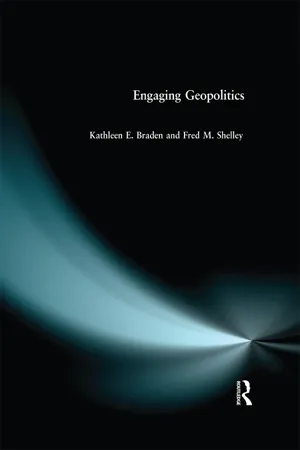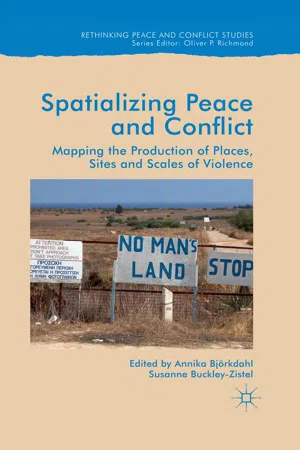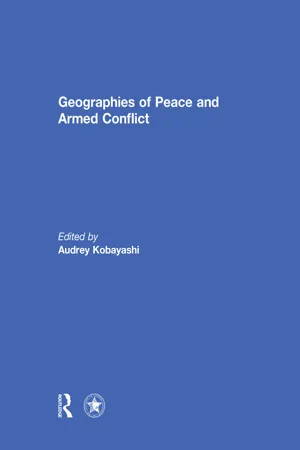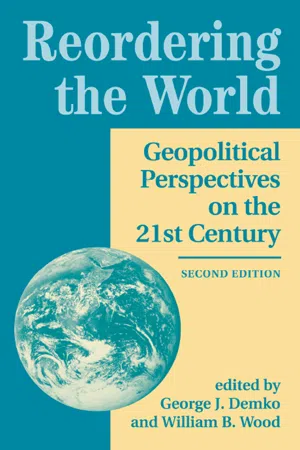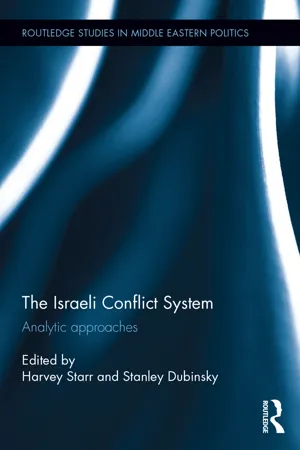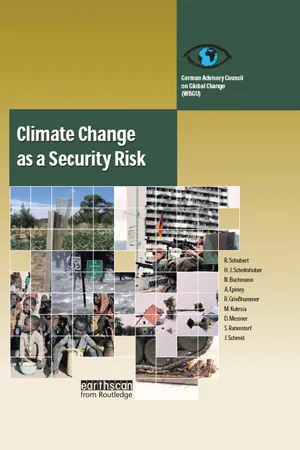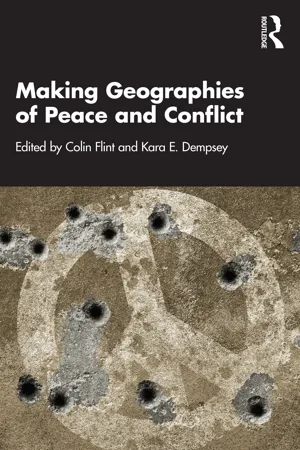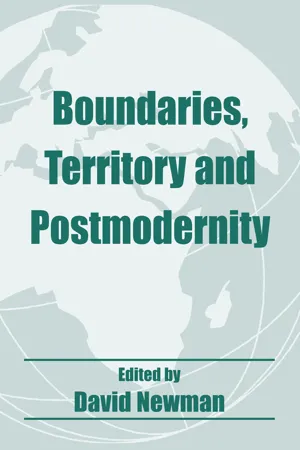Geography
Recent Conflicts
Recent conflicts refer to the ongoing or recent instances of armed confrontations or disputes between nations, groups, or communities. These conflicts can arise due to various factors such as territorial disputes, political differences, ethnic tensions, or resource competition. They often have significant geographical implications, impacting borders, migration patterns, and the physical landscape of the affected regions.
Written by Perlego with AI-assistance
Related key terms
9 Key excerpts on "Recent Conflicts"
- eBook - ePub
- Kathleen Braden, F.M. Shelley(Authors)
- 2014(Publication Date)
- Routledge(Publisher)
Distance plays a key role in most conflicts over history, as neighboring states are more apt to war with each another. Yet some areas of the world are especially prone to conflict, as we saw in Chapter 3. Shatterbelts such as the Middle East and Southeast Asia have experienced numerous armed conflicts over the past centuries. Various approaches to analysis have been made in political geography, from behavioral studies to world systems theories about conflict. In addition to these more traditional ways in which geographic inquiry helps us understand warfare, a new wrinkle on geography and war has been occurring since World War II: the globalization of security threats. This process takes us beyond the realm of traditional borders between states and beyond traditional interstate warfare, to look at the geography of security, not the geography of war. In terms of external or outside threats to citizens of states, borders are becoming more and more permeable despite the best efforts of even wealthy states to protect their citizens. Thus, a new kind of geography, one that looks beyond physical definitions of space to explore perceptual space, and one that moves beyond the state level to global security questions is essential. Four examples of such “unbounded” threats may be noted already within world geopolitics: 1 Weapons technology changes: as nuclear, chemical, and biological weapons evolve, they overcome space barriers more and more effectively. Even so-called conventional weapons are now reaching a level of technology that will put them on a par in destructive power with nuclear weapons - eBook - ePub
Spatialising Peace and Conflict
Mapping the Production of Places, Sites and Scales of Violence
- Annika Bjorkdahl, Susanne Buckley-Zistel, Annika Bjorkdahl, Susanne Buckley-Zistel, Annika Bjorkdahl, Susanne Buckley-Zistel(Authors)
- 2016(Publication Date)
- Palgrave Macmillan(Publisher)
In this chapter we critically review the corresponding debates in conflict studies and examine how they conceptualize spatial categories, both theoretically and empirically. We begin with an overview of how spatial references are made in the mainstream debates in conflict studies, then introduce theoretical reflections of the concept of space in social geography. Next we link the two debates in order to outline how spatial categories can be applied in the analysis of violent conflict in a more productive way. Although the main objective of the chapter is to introduce the subject and to present the state of the art, it concludes by offering a perspective on conflict as social action that is constitutively related to space, and suggesting that space does not determine conflict but that space and conflict mutually produce and reproduce each other.In order to unfold this argument the chapter proceeds as follows. First, we review central debates within conflict studies with regard to how they refer to spatial concepts. We begin with studies on international and civil wars that, since the 1970s, have used geographic categories – such as topography, infrastructure, borders or proximity – as explanatory factors for the occurrence of armed conflict. In the study of civil war, natural resources and territorial control are particularly considered. Next the debate on environmental conflicts – that is, research on the relationship between ecological change and violent conflict – is sketched out as another influential strand within conflict studies, which refers strongly to spatial aspects. Following this we show that most studies of international and civil war and environmental conflict reproduce the container concept of the territorially bounded nation-state.The main problem we identify in conflict studies literature is thus that most studies do not connect physical and material with sociopolitical aspects of collective conflict, therefore perpetuating what has been referred to as methodological nationalism. Wimmer and Glick Schiller (2002) define methodological nationalism as ‘the assumption that the nation/state/society is the natural social and political form of the modern world’ (Wimmer and Glick Schiller 2002: 302). While their concern is with outlining how the epistemic programmes and structures of mainstream social science research are interwoven with modern (capitalist) nation-state formation, in this chapter we confine our critique to one of their three variants of methodological nationalism: the focus on the nation-state as the key, and often only, unit of analysis. - eBook - ePub
- Audrey Kobayashi(Author)
- 2013(Publication Date)
- Routledge(Publisher)
The geography of conflict is an expression and a medium for the myriad power relations that cause and facilitate violence. With a focus on interstate violent conflict, we explore the interaction of geographic and network spaces to understand how war spreads through the exercise of a variety of power relations. Traditional conflict analysis, especially in the field of political science, takes a singular view of power and geography, considering them only as fixed attributes in the context of dyadic relations (between a pair of states). Our approach provides a panoramic conception of relational space that uses dyads as a building block to describe the surface across which conflict spreads, as well as to help us understand how states become involved in an ongoing conflict. Furthermore, as an illustrative example, we are able to analyze how the embeddedness or situation of particular power relations shapes the construction of broader social networks to define the multidimensional and multiactor contexts that facilitated the diffusion of World War I.The purposes of this conceptualization and application are founded on developments within the discipline of geography and also the potential and difficulties of enhancing interdisciplinary conversations between geography and the international relations (IR) discipline. As new theoretical understandings of power have taken root in geography and other social sciences, the study of interstate conflict has lagged behind (Allen 2003; Bosco 2006a); however, little of this language or ontology has pollinated the work of geographers analyzing conflict in a systematic manner. Hence, the application of relational power to conflict has been restricted to case studies in geography that are not framed within the normal science projects typical of IR.Simultaneously, the field of IR has renewed its interest in “geography” but has not developed a sophisticated understanding of the term. Instead, physical distance, contiguity, absolute location, and simplified incorporations of terrain predominate (O’Loughlin 2000). The limitations on the understanding of geography are a function of predominant ontologies and the associated understanding of power. The state is the sole actor in the hegemonic data sets used by IR scholars, and conflict is viewed in dyadic terms; various static relationships between two states in a given year (known as the dyad-year) are the focus of analyses. - eBook - ePub
Environmental Conflict
An Anthology
- Paul Diehl, Nils Petter Gleditsch(Authors)
- 2018(Publication Date)
- Routledge(Publisher)
Environmental Conflict: A Future Research AgendaPassage contains an image
NILS PETTER GLEDITSCHChapter TwelveArmed Conflict and the EnvironmentWar, Resources, and the Environment
After the end of the Cold War, resource and environmental issues have come to the forefront of the study of armed conflict and security. According to a recent study from NATO's Committee on the Challenges of Modern Society, 'NATO looks increasingly at threats from non-traditional sources' and applies a 'new and broader security concept' that 'recognises that security and stability have political, economic, social and environmental elements' (Lietzmann and Vest, 1999: 1). And the German minister of environment argues that 'global environmental degradation ... as well as the depletion of renewable resources ... and non-renewable resources ... are increasingly seen as major contributing factors to conflicts' (Trittin, 2000: vii).Arguments about resource scarcity as a cause of violence are not new in peace research. Pioneers like Quincy Wright (1942/65: ch. 32) and Lewis Fry Richardson (1960: ch. 7) discussed them under the general heading of economic causes of war. But the end of East-West rivalry, which completely dominated international relations for over 40 years, has permitted such factors to appear more clearly.In this line of argument, the prime resource seen as worth fighting for is obviously territory, as in the conflict-filled expansion of European settlers in North America or the border conflicts between China and several neighbors. A more recent variety of territorial conflict concerns the economic zone on the continental shelf, a traditional matter of dispute between countries which are neighbors over water and which may raise tiny islands to monumental importance because of their consequences for boundaries at sea. Thus, there are no less than six claimants to all or part of the Spratly Islands in the South China Sea (Denoon and Brams, 2001), and the use of force cannot be ruled out. Another valuable resource is strategic raw materials. The strategic importance accorded to Indochina in the 1950s was justified by U.S. president Eisenhower—in the statement that made famous the 'domino theory'—with reference to the importance of raw materials such as tin, tungsten, and rubber.1 Some such raw materials are closely tied to arms production, others are simply seen as essential to the economy. A third is sources of energy, the most obvious example being oil supplies from the Persian Gulf, a factor in several Recent Conflicts. A fourth is water, with widely expressed fears that irrigation or dam projects may result in a water shortages downstream and eventually to serious upstream-downstream conflicts (Gleditsch, 1997b: section E). A UN study has identified over 200 major river systems shared by two or more countries, many of them subject to unresolved disputes (Renner, 1996: 60). A fifth resource is food, - eBook - ePub
Reordering The World
Geopolitical Perspectives On The 21st Century
- George J Demko(Author)
- 2018(Publication Date)
- Routledge(Publisher)
Although the range of essays in this volume is deliberately broad, the essays are united by a political geographic framework. Political geography is the analysis of how political systems and structures—from the local to international levels—influence and are influenced by the spatial distribution of resources, events, and groups, and by interactions among subnational, national, and international political units across the globe. Such a definition includes group decisionmaking, organization, and implementation activities that affect natural resources. Political geography focuses, on one hand, on how groups interact—particularly the ways they manipulate each other—in the pursuit of controlling resources and, on the other, on how these social, economic, and political activities determine the use of, and thereby modify, the resource base. The resource most often directly implicated in international conflicts is land, whether for intrinsic (it contains minerals or a fresh water source), strategic (it straddles a key trade route), or nationalistic (it embodies a “homeland”) reasons. The discipline also assesses the political effects of information and resource flows that change spatial distributions and balances of power.The political geography of international relations, then, often comes down to control over key resources and flows—be they a commodity such as oil, a specific border crossing, or the “global commons”—and who is best connected in the global system in terms of communications, trade, and idea flows. Apart from territorial and boundary disputes, other less apparent foreign policy issues are also directly influenced by this perspective. For example, the measure of a “regional power” is its exploitative capability, both militarily and economically, over domestic and foreign resources. Many of our humanitarian crises are the result of the tragic inability of different ethnic groups to share resources and the forced displacement of one group by another, setting up flows of refugees and even “brain power” from one polity to another. And, on the global front, much of our concern over population growth, environmental protection, and sustainable development comes down to the fear that our descendants will be living on a smaller, dirtier, and less exploitable region of the earth’s surface. - eBook - ePub
- Harvey Starr, Stanley Dubinsky(Authors)
- 2015(Publication Date)
- Routledge(Publisher)
how the main contentions take place. By focusing on clusters of conflict events we are not only able to depict what the conflict “looks like” (especially in a graphic or cartographic sense), but are also able to acquire important spatio-temporal information about the conflict. This information can then serve as a basis for investigating a variety of independent variables which could explain the formation of clusters and their movement through time.Conflict analysis with GIS
While substantial work has been done in the past 15–20 years in re-incorporating geography and spatiality into analyses of conflict (e.g., see Starr 2002), much more needs to be done in demonstrating the importance of the spatial context: the relationship between space and time, how space and spatiality can be studied, and the challenges of combining the study of space and time in our analyses of social conflict. A multidimensional concept, “space,” takes on meaning only as it is perceived by individuals or groups of individuals (thus also reflecting the constructivist theme in this volume). Geographers John Agnew and James Duncan (1989) provide three approaches to the idea of “place” (2). They note that geographers usually look at these separately, but that all three meanings are “complementary dimensions” of place; and which, we think, are basic to the meaning of space or spatiality:Approaches to defining a geographical concept of place have tended to stress one or another of three elements rather than their complementarity. Firstly, economics and economic geographers have emphasized location, or space sui generis, the spatial distribution of social and economic activities resulting from between-place factor cost and market price differentials. Secondly, microsociologists and humanistic geographers have concerned themselves with locale, the settings for everyday routine social interaction provided in a place. Thirdly, anthropologists and cultural geographers have shown interest in the sense of place - eBook - ePub
- Hans Joachim Schellnhuber(Author)
- 2010(Publication Date)
- Routledge(Publisher)
Future crisis hotspots are therefore assumed to be located in countries and regions considered problematic in terms of their problem-solving capacity. So far, there has been no evidence that environmental problems are the direct cause of war – that is, there have been no ‘environmental wars’ manifesting the most extreme form of interstate conflict. At least no evidence exists to date to suggest any unambiguous causal links between environmental change and violent interstate conflict. Indeed there are some striking examples in which efforts to solve environmental problems have led to constructive and cooperative engagement between fundamentally hostile parties (e.g. water use between Israel and Palestine or Egypt-Israeli cooperation in the context of the Mediterranean Action Plan). However, it certainly cannot be ruled out that environmental degradation can have destabilizing impacts that may lead to conflict – this remains a plausible possibility, as can be seen from various conflicts in the recent past. 3.2 World map of past environmental conflicts 3.2.1 Resource conflicts over land, soil, water and biodiversity A world map of environmental conflicts that have occurred in the recent past is presented below (Fig. 3.2-1). It is based on close empirical observation of 73 conflicts that occurred in the period between 1980 and 2005, in which environmental problems regarding water use, land use, biological diversity and fish resources played a crucial role. It shows which environmental problem was relevant to which conflict, along with the geographical distribution of the 73 conflicts and their degree of intensity. For purposes of simplification, four different levels of intensity have been identified: (1) diplomatic crises; (2) protests that may entail an element of violence; (3) violent conflicts that affect the entire nation; (4) conflicts characterized by systematic, collective use of violence - eBook - ePub
- Colin Flint, Kara E. Dempsey, Colin Flint, Kara E. Dempsey(Authors)
- 2023(Publication Date)
- Routledge(Publisher)
13 Geographies of environmental peace and conflict Shannon O’LearDOI: 10.4324/9781003345794-13Oil wars. Conflict diamonds. Climate change exacerbated conflict. Environmental features are frequently associated with violence and conflict, but how well do we understand these connections? A geographic perspective is valuable for critiquing assumptions about how environmental features are related to conflict. This chapter reviews key themes in scholarship on resource-related conflict. It also considers how different ways of managing and valuing environmental resources can create multiple geographies of haves and have-nots and of environmental benefits and harms. Even seemingly peaceful relationships involving natural resources warrant close attention through a geographic perspective: What may appear to be peaceful at one spatial scale or through the eyes of particular actors may not be as peaceful from another vantage point.This chapter connects with the overarching themes of this book in several ways. Human interactions with environmental systems involve various forms of agency: Who gets to decide how environmental resources are valued or devalued, who gets to benefit from their use, and who faces negative impacts of these decisions without any agency. Importantly, a critical aspect of human agency in regard to environmental features has to do with our understanding of environmental features and resources and how that understanding informs behavior and practice. This chapter includes examples of how certain ideas about environmental features were formed and how those ideas have continued to shape how we utilize (or disregard) environmental resources. How we value or disregard particular aspects of “the environment” contributes to another theme of this book, namely, multiple geographies. Humans have altered the surface of the planet in many ways with a multitude of results and impacts and at a variety of spatial scales. Yet there are also different approaches to understanding environmental features and how human systems interact with, draw from, or alter environmental systems. Much of the Western world’s relationship to environmental features is grounded in othering and partitioning, which is deeply rooted in the notion that humans and environmental features are separate and distinct. Other ways of understanding the world view humans and environmental features as integrated and dependent on each other for survival. Spaces that are constructed through human interactions with their environmental surroundings reflect variations in political power: power to shape how environmental resources and systems are valued, power to impose a particular set of values on a landscape or waterway, and power to voice alternative ways of valuing environmental systems and our relationship to them. These themes of agency, multiple geographies and spatial scales, partitioning or inclusive views of environmental features, and political aspects of how humans value and (de)value environmental features all come into play in this chapter’s consideration of geographies of environmental peace and conflict. - eBook - ePub
- David Newman(Author)
- 2013(Publication Date)
- Routledge(Publisher)
It is interesting 17 years on, to note that in the first editorial of the, then, new journal, Political Geography Quarterly, the editors saw the research agenda of the journal as focusing on such issues as the spatial organisation of the State, internal state politics and the study of locational conflict. 7 The nearest they came to raising issues which could be defined as falling within the broader realm of geopolitics, was the revival of geostrategic studies and the concept of the nation state. Since that point in time, the research agenda of political geography has undergone major changes and probably sees geopolitics as being no more than one sub-constituent of the wider study of the relationship between politics and space. More recently, the collapse of the Soviet Union and the territorial reordering of Central and Eastern Europe, together with the impact of globalisation and supra-national processes on what is traditionally seen as the Westphalian territorial compartmentalisation of the world into sovereign states, has raised a host of new questions concerning the nature of the world political map. 8 The study of these topics has assisted in the re-legitimisation of Geopolitics as an academic sub-discipline, and has been illustrated in the reports reflecting the development of Political Geography during the past two decades, with the introduction of such concepts as the new world order in 1991, 9 critical geopolitics in 1992, 10 and theorising the nature of the contemporary world disorder in 1995. 11 The final nails in the coffin of geopolitical excommunication were to be seen in two recent international conferences, the one focusing on a reassessment of past geopolitical writings, the other highlighting the contemporary geopolitical research agenda
Index pages curate the most relevant extracts from our library of academic textbooks. They’ve been created using an in-house natural language model (NLM), each adding context and meaning to key research topics.
